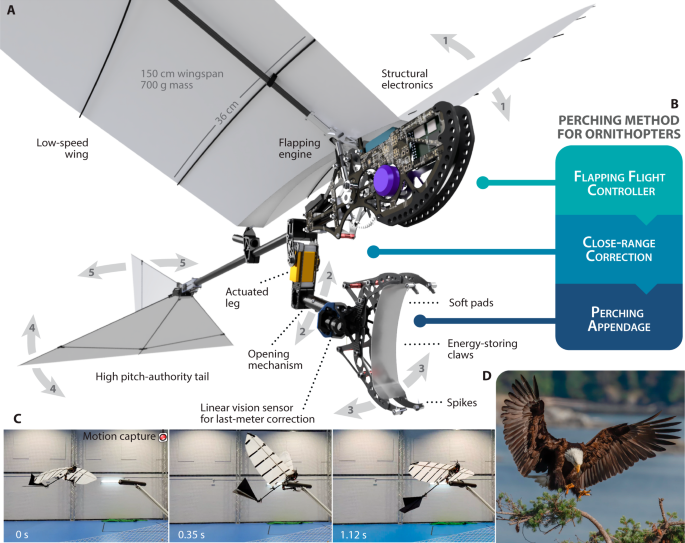2022-12-19 スイス連邦工科大学ローザンヌ校(EPFL)
鳥が枝に止まるという動作は、実はタイミング、強い衝撃力、スピード、そして正確さが非常に微妙なバランスで成り立っています。あまりに複雑な動作のため、羽ばたきロボット(オーニソプター)はこれまでこれをマスターすることができなかったのです。
工学部の知能システム研究室(LIS)とバイオロボティクス研究室(BioRob)の博士研究員であるRaphael Zuffereyは、このような着地を可能にする独自の着陸装置について述べた最近のNature Communications論文の筆頭著者である。セビリア大学では、欧州プロジェクト「GRIFFIN」の一環として700グラムの羽ばたき機を開発し、その同僚と共同でこの羽ばたき機の製作と試験を行いました。
外部からの指令なしに羽ばたき機を着陸させるためには、自然界がすでに完璧なバランスを保っている多くの要素を管理する必要がありました。オーニソプターは、止まりながら飛行速度を大きく落とさなければなりません。また、爪は、止まり木をつかんでロボットの重量を支えるのに十分な強度が必要ですが、重すぎて上空を飛ぶことができないようではいけません。「2本の爪ではなく、1本の爪にしたのはそのためです」とZuffereyは説明する。最後に、ロボットは自分の位置、速度、軌道に関連して、周囲の環境と目の前の止まり木を認識する必要がある。
研究者たちは、鳥型ロボットに完全なオンボードコンピュータとナビゲーションシステムを搭載し、さらに外部モーションキャプチャシステムを使用して自分の位置を特定することで、これらの機能を実現した。また、鳥の脚爪は、止まり木を掴もうとする際に生じる飛行中の上下振動を補正するよう、細かく調整されている。爪は、衝突時にロボットの前方運動量を吸収し、素早くしっかりと閉じて体重を支えるように設計されています。また、一度止まったら、エネルギーを消費することなく止まり続けることができる。
このように、さまざまな要素を考慮しながらも、ズッフェリーたちは最終的に1台だけでなく2台の爪足付き鳥盤を製作し、止まり方を再現することに成功したのだ。
<関連情報>
- https://actu.epfl.ch/news/researchers-develop-winged-robot-that-can-land-lik/
- https://www.nature.com/articles/s41467-022-35356-5
枝に自律的に止まることができるオーニソプターの仕組み How ornithopters can perch autonomously on a branch
Raphael Zufferey,Jesus Tormo-Barbero,Daniel Feliu-Talegón,Saeed Rafee Nekoo,José Ángel Acosta & Anibal Ollero
Nature Communications Published:13 December 2022
DOI:https://doi.org/10.1038/s41467-022-35356-5

Abstract
Flapping wings produce lift and thrust in bio-inspired aerial robots, leading to quiet, safe and efficient flight. However, to extend their application scope, these robots must perch and land, a feat widely demonstrated by birds. Despite recent progress, flapping-wing vehicles, or ornithopters, are to this day unable to stop their flight. In this paper, we present a process to autonomously land an ornithopter on a branch. This method describes the joint operation of a pitch-yaw-altitude flapping flight controller, an optical close-range correction system and a bistable claw appendage design that can grasp a branch within 25 milliseconds and re-open. We validate this method with a 700 g robot and demonstrate the first autonomous perching flight of a flapping-wing robot on a branch, a result replicated with a second robot. This work paves the way towards the application of flapping-wing robots for long-range missions, bird observation, manipulation, and outdoor flight.



